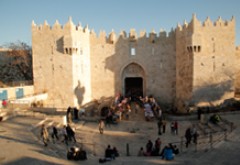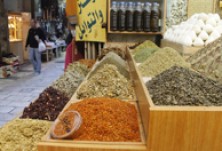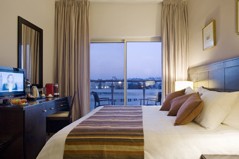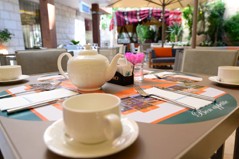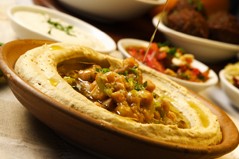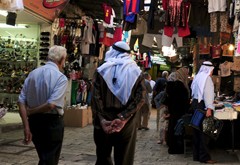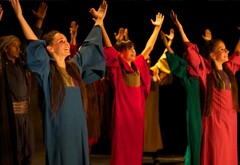African Community
The African community in Jerusalem counts approximately 350 people. To truly understand what brought Africans to Jerusalem and the Middle East, one must recognize the role of Islam in Africa. The expansion of an Islamic empire in Africa started in the 7th century when Arabs started arriving in Africa once Islam had already settled. Many came due to the large slave trade market and for West Africa’s valuable gold. It is important to note slavery occurred before the advent of Islam, and Muslim teachings had always favored manumission. Slavery was a huge trade market within Africa and the Middle East and, unfortunately, not much is recounted from the Africans perspectives. Nonetheless Moroccan explorer Ibn Battuta wrote of his experiences and encounters in the 14th century through a complete cross-cultural outlook, showing Africans humanity. Finally in the 15th and 16th century trade in humans and goods slowed after the collapse of the Kingdom of Songhai, the West African political breakdown, North African economic decline and a shift to Atlantic slave routes. Africans started making the pilgrimage to the Mecca and Jerusalem to fulfill their duties as Muslims.
Islam was a dominant religion in West Africa and it created a link to the Islamic world giving Muslim Africans tangible reasons to cross the Sahara for the first time in history. One of the most memorable pilgrimages in history was made by Mansa Musa in the 14th century. The emperor Mansa Musa of Mali was an extremely wealthy man, and to this day is still one of the richest men that ever lived. He made his journey to the Mecca over the period of one year, bringing with him tons of gold and spending on souvenirs, building mosques and giving to the poor. As a result of his lavish spending he left a destabilized economy and caused mass inflation in Egypt and other countries. Since then, many Muslim Africans have made the journey themselves. Myriad of them settled in Jerusalem considering it the final destination of their pilgrimage.
In the 13th century Mamluk lords Prince Alaa Deen Aydooghdi and Sultan Qalawoon created hostels opposite each other for Muslim pilgrims. During the Ottoman Empire (1516-1918) Africans were deemed important caretakers for the mosque, and many stood as guards and held keys to holy sites. However, during the Arab Revolt against the Turks (1914-1917) the Ottomans converted the two hostels into prisons. One section was meant for rebels and long-term incarceration, and the other for executions, dubbed “The Blood Prison”. Iron bars covering the windows and doors are still present, attesting to its eerie past.
Even through two catastrophic wars, members of the African community don’t consider leaving or returning to their native villages in Africa. While taking pride in their African roots and traditions, they have woven themselves into the Palestinian community; socially and politically. Many have married Arab women, and all of them strongly identify to the Palestinian cause. Unfortunately many Afro-Palestinians have served time in Israeli prisons. Despite considering themselves as Palestinians, Nevertheless Mahmoud Jiddah, a member of the African community, says racism is not a hugely common occurrence from the Palestinians. The worst racism they encounter is by the Israelis; “We face a twofold oppression by the Israeli occupation: first because we are Palestinians and second because we are black”.
The African community is known to be a tight-knit community, and one of the only communities within the Old City that consider themselves Palestinians. Many in the community will tell you they consider themselves one big family. Albeit many traditions have ceased with time and new generations, if an event or occasion is due, everyone takes part and contributes in whatever way they can. However unfortunate due to lack of space, rising unemployment and poverty in the area, many families have had to move out to neighborhoods like Beit Hanina and Shu’fat. Many have tried expanding and building new levels, but obtaining construction permits are very difficult for Palestinians and they are constantly denied by Israeli authorities. Even for basic restoration or addition of one or two rooms, illegal construction is heavily penalized by Israel; if the construction isn’t demolished by the property owner, the government will destroy it and send the bill to the owner.
Overall the African community not only shows their devotion within the Old City and Jerusalem, they also represent the Palestinian narrative through years of perversity and unity. They are a microcosm of the challenges Palestinians have encountered for decades, and still face to this day.
Indian Community
In the early 13th century a few decades after Saladin had driven the Crusaders out of the city, a notable Indian religious figure made his way to Jerusalem. He came from a village in Punjab (now Pakistan) and his birth name was Khwaja Farīduddīn Mas’ūd Ganjshakar but he was better known as Baba Farid. Baba Farid was a devoted follower of Sufism (an Islamic discipline), more specifically the Chisti order which was based on principles of openness, compassion and truthfulness. He was on a journey to Islamic countries for 18 years when he came by Jerusalem and was offered a property by the local Islamic community inside the gates of the Old City. He spent 40 days isolated in prayer, fasting and spending a lot of his time at Al Aqusa mosque. Once he left, the site was known as Az-Zawiya al-Faridiya, a charitable property meant for the purpose of prayers. Returning to India he eventually became the head of the Chisti order and Indian Muslims who cherished him very much made the pilgrimage to Jerusalem and followed in his footsteps, praying in the same places he had. With the influx of Indian Muslims arriving in Az-Zawiya al-Faridiya, a shrine and lodge was made dedicated to his Baba Farid’s dervishes—thus the Indian Hospice in Jerusalem was founded.
The year the Ottoman Empire collapsed; in 1922 was when the Indian Hospice was about to flourish. Sufi groups all over the Islamic world joined Indians in Jerusalem and funds started coming in, building new schools and mosques. In 1923 the Islamic Higher Supreme Council sent a delegation to join the Khilafat movement in India and meet with wealthy Muslim men and women to tell them of the lodge, hoping to receive donations for restoration. They also wanted to recruit someone to come to Jerusalem, take charge of the lodge and revive the idea of Jerusalem as a holy land for Indian Muslims. Nazir Hasan Ansari arrived to Jerusalem in 1924 and was the Sheikh for 27 years, not only restoring people’s faith but also enabled great improvements to the lodge. From the 1920’s to the 1930’s, Sheikh Nazir travelled regularly to India, meeting with Princes and other notable wealthy Muslims, telling them about the Indian Hospice persuading them to pay for repairs. Sheikh Nazir married a Palestinian woman, and in 1928 she gave birth to their son, Munir.
People came from India to Jerusalem in ships bringing with them food and spices, keeping their traditions close. Sadly in the late 1940’s, the war and tensions in the city of Jerusalem and resulted in a scarce amount of pilgrims arriving. Before 1948 when the Arab-Israeli war broke out, the lodge had been a leave camp for the Indian Fourth Infantry division (the first Indian division to go overseas in WWII), and after 1948 the lodge was rundown by shelling and swarmed with Palestinian refugees. In 1967 during the Six-Day War the Indian hospice was once again almost pulverized by rockets. Wounded and despaired Jordanian soldiers asked for refuge at the hospice, then at night ran away leaving behind their uniforms and weapons. The second day of the war the Israelis came into the Old City and bombarded the hospice. After several casualties and having witnessed the lodge turn into ruins, the morale of the community was low. Sufism had been seen by some as an anachronism. That said the community did not let their faith astray and refused to abandon their home and years of hard work. Baba Farid had had a big impact on Sufis; they believed in a tradition that ‘spoke more of God’s gentleness than of his severity’. The first pilgrims that came to Jerusalem brought instruments and melodies from the Punjab, which was Baba Farid’s native village. They sung verses of Baba Farid’s poetry that had been written in Punjabi, which was unheard of at the time as literature was written in Arabic or Sanskrit. This laid a foundation for Punjabi literature, which has evolved successfully ever since.
Today, the head of the Indian Hospice is Sheikh Muhammed Munir Ansari, the son of Sheikh Nazir. He was given an award in 2011, the Pravasi Bharatiya Samman by the Indian President for exceptional service to the country. To this day, the Indian Hospice is in very good condition; has a library, mosque and guest rooms for Indians who still occasionally visit.

